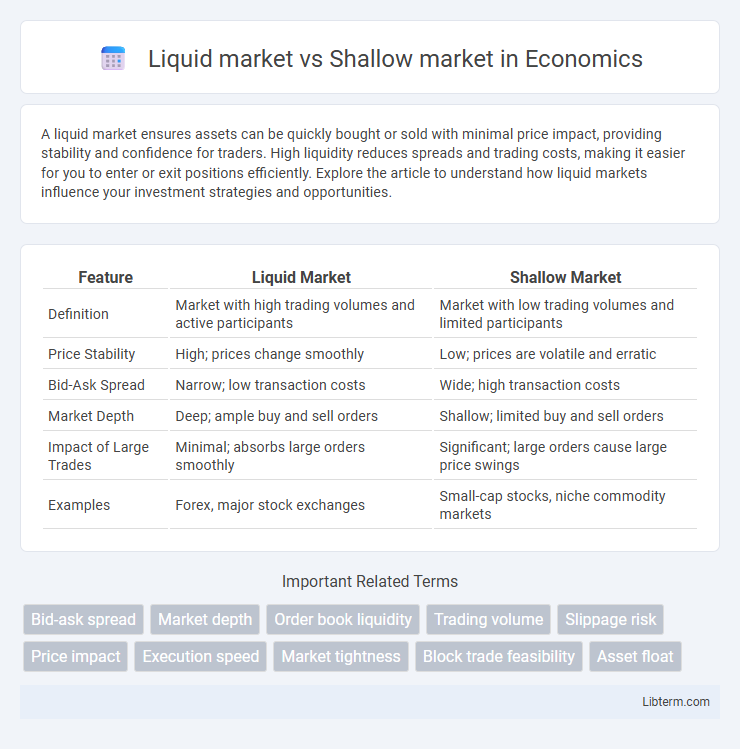A liquid market ensures assets can be quickly bought or sold with minimal price impact, providing stability and confidence for traders. High liquidity reduces spreads and trading costs, making it easier for you to enter or exit positions efficiently. Explore the article to understand how liquid markets influence your investment strategies and opportunities.
Table of Comparison
| Feature | Liquid Market | Shallow Market |
|---|---|---|
| Definition | Market with high trading volumes and active participants | Market with low trading volumes and limited participants |
| Price Stability | High; prices change smoothly | Low; prices are volatile and erratic |
| Bid-Ask Spread | Narrow; low transaction costs | Wide; high transaction costs |
| Market Depth | Deep; ample buy and sell orders | Shallow; limited buy and sell orders |
| Impact of Large Trades | Minimal; absorbs large orders smoothly | Significant; large orders cause large price swings |
| Examples | Forex, major stock exchanges | Small-cap stocks, niche commodity markets |
Understanding Liquid and Shallow Markets
Liquid markets feature high trading volumes and tight bid-ask spreads, enabling rapid execution of large orders with minimal price impact. In contrast, shallow markets have low liquidity, characterized by wide spreads and fewer participants, causing significant price volatility when sizable trades occur. Understanding these differences is crucial for traders aiming to optimize transaction costs and manage market risk effectively.
Key Characteristics of Liquid Markets
Liquid markets feature high trading volumes and tight bid-ask spreads, enabling rapid execution of large orders without significant price impact. They exhibit deep order books with numerous buyers and sellers, fostering price stability and minimal volatility. In contrast, shallow markets suffer from low liquidity, wider spreads, and greater price fluctuations, making them less efficient for trading.
Key Characteristics of Shallow Markets
Shallow markets exhibit low trading volumes, resulting in limited liquidity and increased price volatility due to insufficient buy and sell orders. These markets often experience wider bid-ask spreads and higher transaction costs, deterring large traders and causing inefficient price discovery. The lack of market depth in shallow markets makes them more susceptible to manipulation and sudden price swings.
Trade Volume: A Core Differentiator
Trade volume serves as a fundamental differentiator between liquid and shallow markets, with liquid markets exhibiting high daily trading volumes that facilitate swift and efficient asset transactions. This significant trade volume minimizes bid-ask spreads and enhances price stability, attracting institutional investors and promoting market confidence. In contrast, shallow markets suffer from low trade volumes, leading to higher price volatility and difficulty executing large orders without impacting the asset price.
Price Stability: Liquid vs. Shallow Markets
Liquid markets exhibit high trading volumes and tight bid-ask spreads, which promote price stability by enabling seamless transaction execution without causing significant price fluctuations. Shallow markets, characterized by low liquidity and wider spreads, often experience higher price volatility as even modest trades can lead to sharp price swings. Consequently, liquid markets support more reliable pricing and reduced risk for traders compared to shallow markets.
Impact on Buy and Sell Transactions
Liquid markets enable rapid buy and sell transactions with minimal price impact, supporting high trade volumes and tighter bid-ask spreads. Shallow markets experience greater price volatility and slippage due to lower trading volumes and limited order book depth, increasing transaction costs for buyers and sellers. Efficient liquidity in liquid markets fosters smoother price discovery, whereas shallow markets often reflect inefficiencies and higher market impact.
Examples of Liquid and Shallow Markets
The New York Stock Exchange exemplifies a highly liquid market with vast trading volumes and tight bid-ask spreads, enabling quick asset conversion. In contrast, rare collectibles like vintage stamps represent shallow markets where low trading frequency and wide price fluctuations limit liquidity. Cryptocurrency exchanges, such as Binance for Bitcoin, demonstrate liquidity, whereas niche tokens with few buyers and sellers illustrate shallow market conditions.
Risks Associated with Shallow Markets
Shallow markets exhibit low liquidity, causing large price fluctuations and increased volatility due to limited buy and sell orders. The spread between bid and ask prices widens, leading to higher transaction costs and execution risks. Investors face challenges such as difficulty entering or exiting positions quickly, increasing the risk of significant losses.
Benefits of High Market Liquidity
High market liquidity facilitates faster transactions and reduces bid-ask spreads, enhancing price efficiency and market stability. Traders experience lower transaction costs and less price volatility in liquid markets, promoting greater confidence and participation. This environment attracts institutional investors, driving deeper market depth and sustained economic growth.
Strategies for Navigating Less Liquid Markets
Navigating less liquid markets requires strategies such as limit orders to control entry and exit prices, reducing slippage risks common in shallow markets. Traders often diversify across assets to mitigate volatility and employ longer time horizons to capitalize on price movements without forcing quick trades. Emphasizing market depth analysis and volume indicators helps identify optimal trading windows, enhancing execution efficiency in less liquid environments.
Liquid market Infographic

 libterm.com
libterm.com